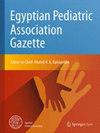Clinical and laboratory spectrum of hereditary angioedema in a group of Egyptian children: a cross sectional study
IF 0.5
Q4 PEDIATRICS
引用次数: 0
Abstract
Hereditary angioedema (HAE) is a hereditary illness represented by repeated bouts of submucosal or subcutaneous edema. Types of HAE includes; HAE with deficient C1-inhibitor (type 1), HAE with dysfunctional C1-inhibitor (type 2), and HAE with normal C1-inhibitor. Data on the epidemiology of HAE in Egypt are limited. Therefore, we aimed to characterize HAE in Egyptian children, identify the morbidity, and clarify HAE's different clinical and laboratory presentations. In this cross-sectional study, we enrolled pediatric patients diagnosed with HAE according to the international hereditary angioedema WAO/EAACI guidelines. We gathered laboratory data on patients' mean serum C1 esterase inhibitor (C1-INH) level and activity, C4, and IgE levels. We included 18 HAE patients (14 females and 4 males). They were between the ages of 6 and 18 years. The mean age upon confirmation of diagnosis was 8.4 ± 2.4 years. The mean time required to correctly diagnose HAE was 3.2 ± 1.8 years. We detected type I in 15 cases and type II in three cases. Eleven patients had a family member with HAE. In terms of previous misdiagnoses, 50% of patients were diagnosed with allergic angioedema. The median annual frequency of episodes was 17. The mean HAE attack time was 2.9 ± 1.5 days. Edema was most typically found in the face and abdomen. Trauma was the main triggering factor. We detected a significant direct relationship between severity of attack and C1-INH activity level. This research adds a considerable clinical information about children with HAE. According to current results, there is a considerable underdiagnosis of HAE in Egypt. The detection and management of HAE can be improved by screening the relatives of HAE patients.一组埃及儿童遗传性血管性水肿的临床和实验室谱系:一项横断面研究
遗传性血管性水肿(HAE)是一种遗传性疾病,表现为反复发作的粘膜下或皮下水肿。遗传性血管性水肿的类型包括:缺乏 C1 抑制剂的遗传性血管性水肿(1 型)、C1 抑制剂功能失调的遗传性血管性水肿(2 型)和 C1 抑制剂正常的遗传性血管性水肿。有关埃及 HAE 流行病学的数据十分有限。因此,我们旨在了解埃及儿童 HAE 的特征,确定其发病率,并阐明 HAE 不同的临床和实验室表现。在这项横断面研究中,我们根据国际遗传性血管性水肿 WAO/EAACI 指南招募了被诊断为 HAE 的儿童患者。我们收集了患者平均血清 C1 酯酶抑制剂(C1-INH)水平和活性、C4 和 IgE 水平的实验室数据。我们纳入了 18 名 HAE 患者(14 名女性和 4 名男性)。他们的年龄在 6 至 18 岁之间。确诊时的平均年龄为(8.4 ± 2.4)岁。正确诊断 HAE 所需的平均时间为 3.2 ± 1.8 年。我们在 15 例患者中发现了 I 型,在 3 例患者中发现了 II 型。有11名患者的家庭成员患有HAE。就先前的误诊而言,50%的患者被诊断为过敏性血管性水肿。每年发作频率的中位数为17次。HAE的平均发作时间为2.9 ± 1.5天。水肿最典型的部位是面部和腹部。创伤是主要诱发因素。我们发现,发作的严重程度与 C1-INH 活性水平有明显的直接关系。这项研究为 HAE 儿童提供了大量临床信息。根据目前的结果,埃及对 HAE 的诊断严重不足。通过筛查HAE患者的亲属,可以改善HAE的检测和管理。
本文章由计算机程序翻译,如有差异,请以英文原文为准。
求助全文
约1分钟内获得全文
求助全文
来源期刊

Egyptian Pediatric Association Gazette
PEDIATRICS-
自引率
0.00%
发文量
32
审稿时长
9 weeks
期刊介绍:
The Gazette is the official journal of the Egyptian Pediatric Association. The main purpose of the Gazette is to provide a place for the publication of high-quality papers documenting recent advances and new developments in both pediatrics and pediatric surgery in clinical and experimental settings. An equally important purpose of the Gazette is to publish local and regional issues related to children and child care. The Gazette welcomes original papers, review articles, case reports and short communications as well as short technical reports. Papers submitted to the Gazette are peer-reviewed by a large review board. The Gazette also offers CME quizzes, credits for which can be claimed from either the EPA website or the EPA headquarters. Fields of interest: all aspects of pediatrics, pediatric surgery, child health and child care. The Gazette complies with the Uniform Requirements for Manuscripts submitted to biomedical journals as recommended by the International Committee of Medical Journal Editors (ICMJE).
 求助内容:
求助内容: 应助结果提醒方式:
应助结果提醒方式:


